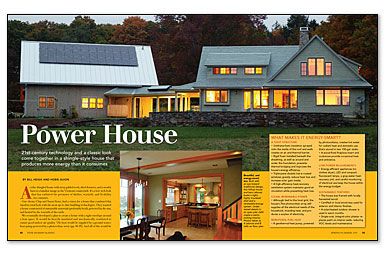Power House
21st-century technology and a classic look come together in a shingle-style house that produces more energy than it consumes.

Synopsis: Vermont’s homes and barns have a quintessentially timeless, rural look. When the authors, builders Bill Heigis and Hobie Guion, met with their clients, they were charged with combining this familiar image with the most up-to-date building technologies. Their clients wanted a house built with local, sustainable materials, powered by the sun and heated by the warmth of the earth. The result is a net-zero energy use home with a tight envelope around a lean space, heavily insulated and mechanically ventilated, and heated by a ground-source heat pump powered by a photovoltaic array. What else makes this house net-zero? A Metlund on-demand hot-water system, a GFX gray-water heat-recovery system, an Esse Ironheart woodstove, and a Kenmore induction cooktop, to name a few. All of this is wrapped in finely crafted woodwork, hand-troweled plaster, and native stone. Oh, yeah: There’s a barn, too.
A cedar-shingled house with steep gabled roofs, shed dormers, and a nearby barn is a familiar image in the Vermont countryside. It’s a low-tech look that has radiated the promises of shelter, warmth, and livability for centuries.
Our clients, Chip and Susan Stone, had a vision for a home that combined this timeless rural look with the most up-to-date building technologies. They wanted a house constructed of sustainable materials (preferably local), powered by the sun, and heated by the warmth of the earth.
We eventually developed a plan to create a house with a tight envelope around a lean space. It would be heavily insulated and mechanically ventilated to ensure good indoor-air quality. The heat would be supplied by a ground-source heat pump powered by a photovoltaic array. And all of this would be wrapped in finely crafted woodwork, hand-troweled plaster walls, and native stone details. Here’s how we did it.
Find the sweet spot between comfort and conservation
From the start, the overarching concept was to make a net-zero house: one that uses renewable resources such as photovoltaics to create as much or more energy than it consumes. Our strategy was to build an airtight, highly insulated structure, minimize energy use with efficient appliances and lighting, and heat the house with a ground-source heat pump powered by photovoltaic panels.
After settling on the shell-construction methods, we considered other ways to minimize energy loads and still meet the needs for heating, hot water, and other electrical consumption. Although the house is grid-connected, it has a solar array designed to generate as much electricity as the homeowners use in a typical year. We also installed a batch solar water heater by the outdoor shower and the barn sink for three-season use. This helps to reduce demand on the heat pump, which is more efficient at producing 100°F water for the heating system than 120°F domestic hot water.
In keeping with the net-zero goal, the house incorporates many energy saving appliances and fixtures. For lighting, compact-fluorescent bulbs are the default, but near the end of the project, we found and installed seven LED recessed cans in the kitchen (www.creelighting.com). Energy Star appliances include an electric induction cooktop, a front-loading washer, a Bosch dishwasher, and a bottom-freezer Amana refrigerator. The Stones do not own a clothes dryer and instead have opted for a clothesline and, when the weather doesn’t cooperate, an indoor drying rack.
Other mechanicals we specified to save energy include a GFX gray-water heat recovery system (www.gfxtechnology.com) and a met lund on-demand hot-water recirculating system (www.gothotwater.com) for the master bathroom. A high efficiency Venmar He-1.3 heat-recovery ventilation system (www.venmar.ca) provides balanced fresh air to this extremely tight house and exhausts stale, moist air from the showers, eliminating the need for bath fans that waste energy.
For more photos, drawings, and details, click the View PDF button below:
Fine Homebuilding Recommended Products
Fine Homebuilding receives a commission for items purchased through links on this site, including Amazon Associates and other affiliate advertising programs.

Loctite Foamboard Adhesive

Great Stuff Foam Cleaner

Nitrile Work Gloves


























